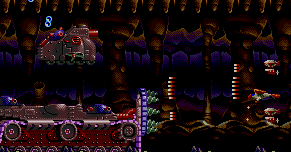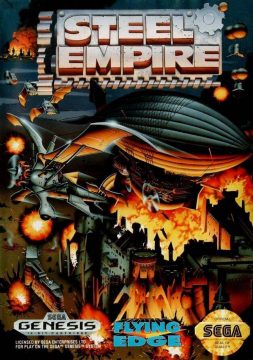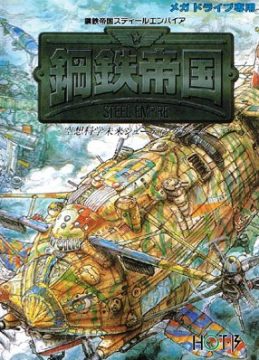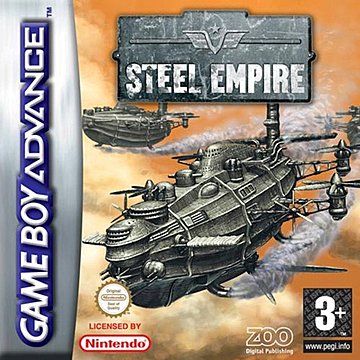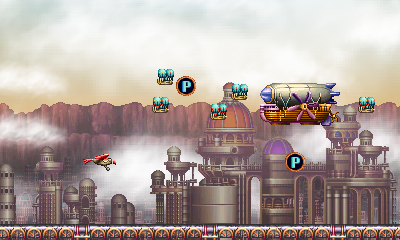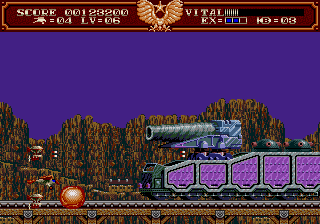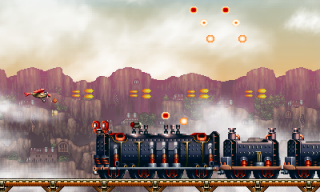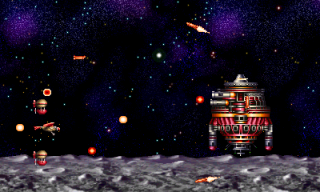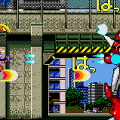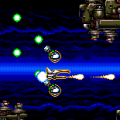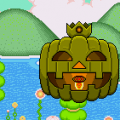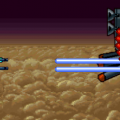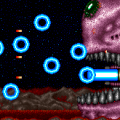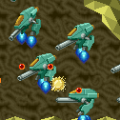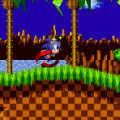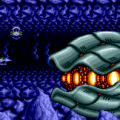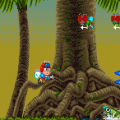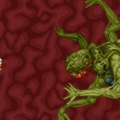Steel Empire, developed by Hot-B, was one of the titles to break away from these themes, instead taking place in a steampunk setting. The world design is inspired by the works of Jules Verne, as well as classic anime like Mirai Shounen Conan. Most flying vessels are either biplanes or dirigibles; many enemies are steam-powered trains. In the year 18XX, most of the world is dominated by an empire called the Motorheads. The only free nation left is the Republic of Silverhead, who sends a lone pilot to destroy the Motorhead forces. The menu screens present the story as if it were a displayed via an old projector, with flickering, sepia toned images. The ending take the scenario a few steps further, by listing fake credits as if it were a movie, based on a non-existent book by a non-existent author, purportedly written in the early 19th century. It does get a little bizarre by the final stage, which sends the ships into outer space, with the final battle being fought on the surface of the moon.
There are two ships: the Striker, a biplane, and Z-01, a zeppelin. The biplane is more agile but weaker; the blimp is slower, with a larger hitbox, but more powerful. The primary weapon is a standard rapid fire cannon, but taking a note from the developer’s previous shooter, the excellent Famicom title Over Horizon, there are separate buttons to fire both forwards and backwards. The third button is used to lob bombs that clear the screen using a lightning attack.
In some ways, Steel Empire feels a bit like a euroshmup. The levels are long and the terrain is spartan. Enemies typically takes several hits to kill, even popcorn enemies, and your ships have a relatively lengthy life bar rather than exploding with a single hit. Euroshmups are usually derided by the community since its forgiving nature lead to lazy design where little care is put into the balance or enemy patterns, but Steel Empire doesn’t really suffer from this. But neither the enemies nor the bullet patterns become too overwhelming. In fact, the game was expressly designed for shooter novices, so it’s on the easy side. Some levels do drag on in spots though, and it takes about 45 minutes to play through the game’s seven stages.
In the initial Genesis release, your firepower starts at level 1, increases with every three P icons you grab, and maxes out at level 20. You never lose your power level, even after continuing – at worst you lose your ship’s satellites, which are easily regained. It’s a little strange since you start off so weak, so you feel underpowered in the early stages, but issue resides once you get farther.
The Game Boy Advance version was developed by Starfish, and released only in Japan and Europe. Whereas many 16-bit ports to the platform simply reused the same graphics with small palette changes, the graphics here are almost entirely redrawn. Both the sprites and the backgrounds are more detailed, with added layers of parallax scrolling. Even though the palette is brighter in order to accommodate the non-backlit GBA models, it still channels the same sense of grittiness. The music, like many GBA ports, is tinny and not terribly great.
The level designs and enemy patterns have been adjusted to take into account the smaller screen. With this, many of the bosses have been redesigned. For example, the train at the end of the first level originally had a huge cannon on its last car, which is missing from the portable release. The final boss is completely different – the Genesis version has a small ship which uses a variety of flame attacks, while the portable version has an orb shaped vessel that’s more visually consistent with the rest of the bosses in the game. Despite the efforts to rebalance, it still feels cramped, and ends up feeling more difficult than its console counterpart.
The weaponry system has been rebalanced too. The firepower maxes out at level 7, however, the number of P icons required to upgrade changes with each level. Furthermore, you drop one level whenever your ship is destroyed. In some senses it’s a little better than the original, since the lower levels are more powerful than their equivalents in the Genesis version, but the fact that you can potentially end up underpowered in the final levels makes for an irritating contrast.
The 3DS version was ported by Starfish in conjunction with another development team named Mebius, and represents a compromise between the two previous versions. This was later used as a basis for a modern Windows port. The visuals are based on the GBA port, but everything has been redrawn at a higher resolution, and the end result looks fantastic. The playing field is much larger, expanded even over the Genesis version, since the status bar information has been moved to the bottom screen.
The bosses are all based on the GBA release, however, the powerup system returns to the persistent leveling in the Genesis release. The music is a step above the GBA version, but the instrument samples sound a little cheap, and they’re missing the impact of the old FM tracks, even though compositionally they’re still pretty good.
While the 3DS version is the best version of Steel Empire, it’s still a fairly barebones port, compared to other modern shooters. It keeps track of your progress in between levels if you need to shut it off, and there’s a training mode to replay any beaten level at max power. But other than an achievement system, there’s nothing else that’s been added. The game was published in North America by Teyon.
Whichever version you go with, Steel Empire is a pretty decent shooter, if mostly for the aesthetics and the music, in the case of the Genesis version.
Links
Yoshinori Satake – Steel Empire, Over Horizon Interview A translated interview with one of the developers.
Screenshot Comparisons
First Boss
Last Boss
